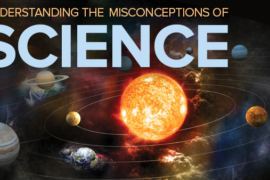
Start with no tools and just using our senses look at the most basic concept of Physics: Mass, Length and Time. Then ask what kind of mass, length and time can we define? No math, no instruments, and no analysis of any kind, only our bare senses. Using standard international units of M for mass (in kilograms), L for length (in meters), and T for time (in seconds), what are the smallest and largest units we can perceive?
What is the smallest unit of mass perceivable: certainly we can tell the difference between a gram and a kilogram. So a safe bet would be a fraction of a gram. What is the largest unit of mass we can perceive? We can definitely tell the difference between 10 and 100 kilogram, maybe for weight lifters the upper limit is probably 1000 kilogram.
In scientific terms our perception range for mass lies between ![]() kilogram.
kilogram.
What is the smallest unit of length perceivable: a millimeter is a safe bet. maybe a fraction of a millimeter. What is the largest unit of length we can perceive? We can definitely tell the difference between 1 and 10 kilometer, maybe the upper limit is probably 100 kilometer.
In scientific terms our perception range for length lies between ![]() meters.
meters.
What is the smallest unit of time perceivable: a blink of an eyelid, a fraction of a second. What is the largest unit of time we can perceive? In a sensory deprivation environment you loose time perception beyond 100 days.
In scientific terms our perception range for time lies between ![]() seconds.
seconds.
This is the world of intuition. This is the scale at which we are hard wired to operate. This is the universe for people operating on their intuition. Call this the world of middle dimension.
But now ask, at what scale does the Universe itself operates at? Are you ready for a surprised? Using our intelligence coupled with instruments, here is what we know.
What is the smallest unit of mass measurable, the electron. The electron mass is measured at ![]() kilograms.
kilograms.
What is the largest mass we can think of, The mass of the known universe. Take an average star like our sun and multiply it by the estimate of the number of stars in our galaxy and multiply that by the estimated number of galaxies.
Our sun is ![]() kilograms. There are
kilograms. There are ![]() stars in an average galaxy and there are
stars in an average galaxy and there are ![]() galaxies. The estimate for mass of the universe then is at least
galaxies. The estimate for mass of the universe then is at least ![]() kilogram. Nature’s mass scale is between
kilogram. Nature’s mass scale is between ![]() kilogram, over 80 orders of magnitude.
kilogram, over 80 orders of magnitude.
What is the smallest length know, Plank’s length. This is constructed from the three fundamental constants of nature. Plank’s constant h, the speed of light in vacuum c and Newton’s gravitational constant g. These are natural constants, measured, not something we created, and coincidently their combinations have units of mass length and time.
What is the largest length we can think of, The radius of the known universe.
This implies that nature operates on length scale between ![]() meters. That’s almost 60 orders of magnitude.
meters. That’s almost 60 orders of magnitude.
What about time, again Plank’s time is the smallest unit we can construct. What is the longest time, the age of the universe 13.7 billion years.
Again, nature operates between ![]() seconds, that’s also almost 60 orders of magnitude.
seconds, that’s also almost 60 orders of magnitude.
Now remember these are orders of magnitudes, the range of middle dimensions is about 7 to 8 orders of magnitude. On the other hand nature operates on a scale of 60 to 80 orders of magnitude, maybe more. What does all this mean?
Take a sheet of paper and draw a pencil line on it. That 1mm wide line illustrates the size our middle dimension, the extent of our experience, a width of a pencil line. How big would a sheet of paper need be to encompass the scale that nature operates on? That sheet of paper would be bigger than the size of our galaxy. In fact it would need to be two to three times that size.
Our experience walks on a pencil thin line on a sheet of paper twice the size of our galaxy. Our experience see’s so little of nature that for practical purposes it’s zero. Yet everyone perceives an understanding of nature to some extent. This is based on the false conjecture that the working of a narrow 1 millimeter middle dimensional experience can be extrapolated to twice the size of our galaxy.
It’s important to understand that you can’t feel, touch, or sense, the scales that the universe operates on. You have to think and use mathematics. To think mathematically, you must abandon subjective notions and opinions and the reliance on the hard wired genetically developed instincts for perception. The use of intellect and the knowledge of mathematics is a way to gain this understanding.

 PacificRimTackle
PacificRimTackle
